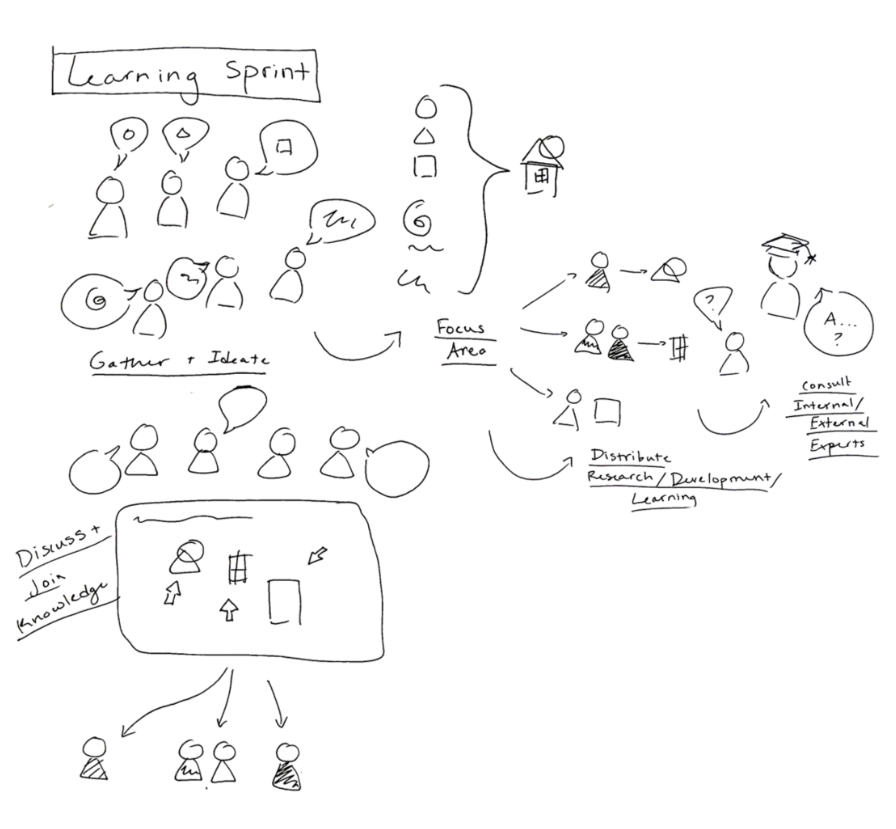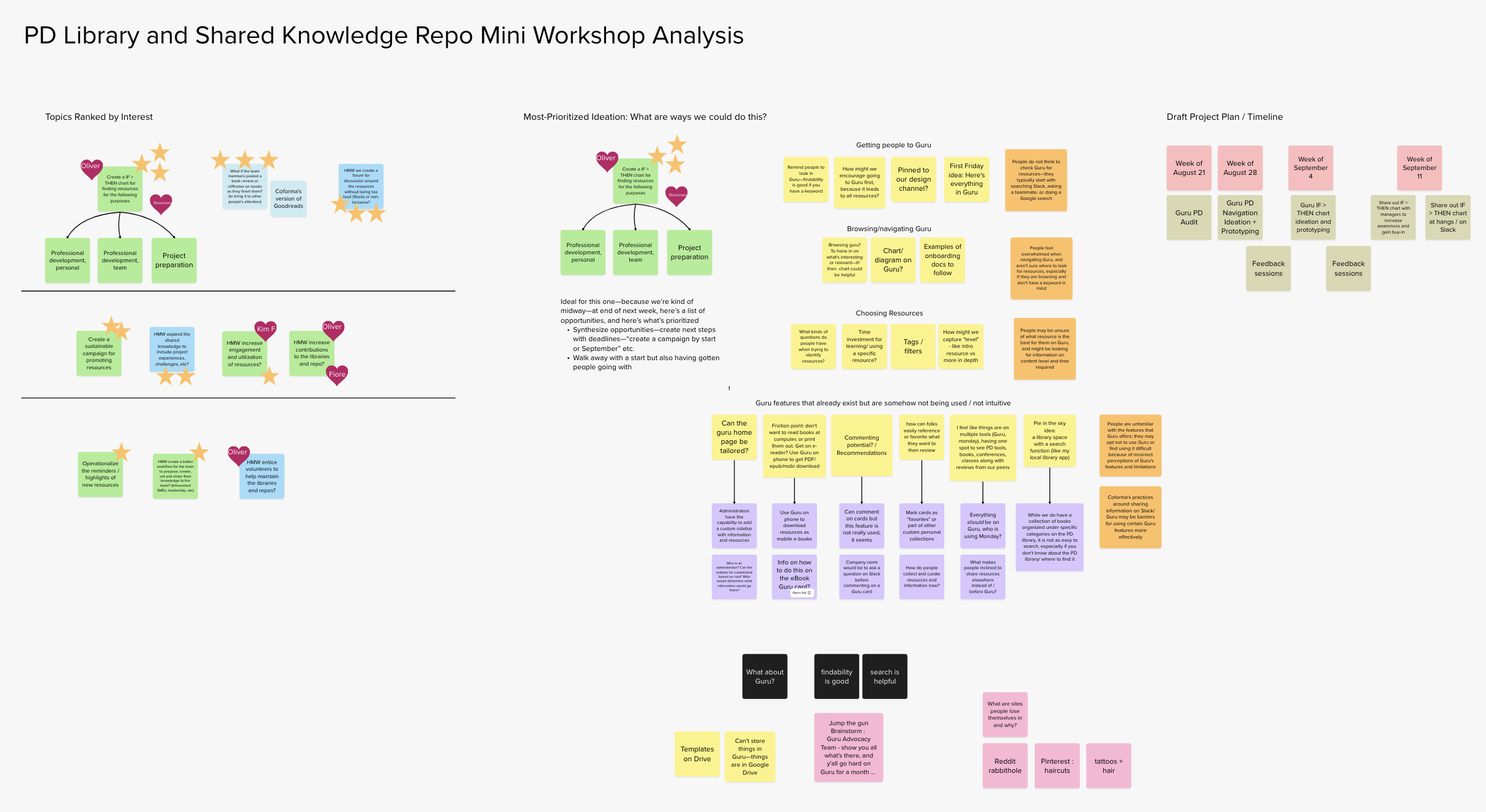Coforma Cohort Builder: A service design project.
At Coforma, I was part of a project that aimed to improve the professional development process. I conducted a design sprint to identify pain points, and stakeholder wishes. The finished product included a re-haul of the professional development process and a cohort-builder template, making learning at Coforma both social and fun.
Coforma. Role: UX Research/Design Intern. 2023.
Skills: Agile/Design sprints, Sprint facilitation, Storyboarding, User testing, Figma, Mural, Guru, Dovetail.
Author’s note: This post has been adapted from a retrospective myself and Calgary, my fellow intern, wrote at the end of our Coforma internship for leadership at the company. I hope that this post shows my experience working as a leader on a design team and my ability to advocate for my work from a company perspective.
Question: How can we improve the professional development process at Coforma?
Professional development is a priority at Coforma. In 2022, the company invested more than 1,000
hours in the growth of its employees. All Cofolx receive an annual $2,000 professional development stipend and can participate in monthly brown bag lunches focused on topics related to work, leadership, and the world around us.
In addition, the Coforma DesignOps team builds and maintains a library of resources, information, and expertise to support the goals and work of our Design and Research practices. However, with busy project-focused days, it can be difficult for Coforma’s designers and researchers to find the time and space to learn and apply new methods.
As Design and Research interns working in DesignOps this summer, we applied human-centered design methodologies to this internal dilemma. Our goals for this project were to develop recommendations to improve the existing resources and processes of knowledge sharing for Coforma’s designers and researchers.
How did we do it?
Starting with understanding
To fully understand the difficulties designers and researchers had with the existing resources and
their desires for future resources and processes, we began by reviewing transcripts from a DesignOps listening tour in May 2023 which explored their experiences, hopes, and challenges. Using data
tagging and analysis, we gained an understanding of their difficulties and opportunities with the
current professional development options. Through a mini prioritization and ideation workshop, we further refined our understanding of the strengths and weaknesses of the existing offerings and
structures.
Workshops with Coforma teams contextualized our understanding of professional development pain points.
From this research, we determined that Cofolx on the Design and Research teams wanted
easy-to-navigate resources, guidance on knowledge sharing, and more opportunities to use projects
as an opportunity to learn and develop their skills. Participants were full of ideas, questions, and
energy around professional development, creating an opportunity for us as interns to engage
full-time employees in this short-term project.
Conducting a design sprint
We chose and modified the five-day design sprint approach to investigate our questions related to
Coforma’s professional development offerings and its knowledge base. To maximize involvement while minimizing impact, we streamlined two distinct design sprints into three, one-hour sessions, opting to take on the synthesizing, prototyping, and testing work ourselves. This format had a few benefits:
Shortened timeline reduced time burden
Increased employee availability retained input/ideation quality
Collaborative structure increased buy-in from Cofolx and users
We started these sprints with two distinct problem statements about the pain points surrounding
personal professional development and project professional development. After reading these to a
group of design and research stakeholders, we worked with participants to generate “how might we” questions, then used affinity mapping to group similar ideas and organize questions by theme. Using asynchronous voting, we identified the questions that interested them most.
After ideation, I guided participants through affinity mapping of “How Might We”s and voting.
With those questions in mind, we led participants through quick ideation sketches, then more
detailed solution sketches to explore potential ideas and identify areas of overlap. In a final
workshop, we generated hypotheses and sketched storyboards to help build out our primary
concepts: for progressing on an individual development plan, a collaborative syllabus builder for
learning cohorts; for project-oriented professional development, a template to integrate professional
development goal setting, work, and check-ins into existing project structures.
Prototyping and testing
I created a prototype to support the formation of learning cohorts for professional development.
Based on inputs from Cofolx on the Design and Research teams, the sprint templates, and desk
research, I recommended groups of two to ten indiduals form a cohort for approximately six weeks
with the goal of learning about a skill or topic. My prototype serves as a guide for syllabus creation,
resource accumulation, and goal formation.
After designing the prototype, I moved to user testing, completing brief, 30-minute feedback
sessions focusing on prototype usability and user flow. Using Cofolx for user testing had a few unique benefits:
I was able to test with the future user population, increasing both user buy-in and specificity of my results.
Many designers and researchers came into testing sessions with additional expert insight on professional development processes.
Testing with designers and researchers allowed for design evaluations from established professionals.
Cohorts are guided through goal ideation and resource collection…
…Which is then used to build out a weekly study group schedule.
What did we learn?
All of the designers and researchers we talked to were excited about professional development and
committed to improving it. We learned that when you give people the tools to learn, they have an
almost-inexhaustible appetite for learning. Through developing and testing our prototypes, however,
we identified four essential ingredients to cultivating professional growth at Coforma:
Time:
Designers and researchers mentioned that even when they wanted to
continue professional development, they weren’t sure how to make time in their schedule for it. We met this challenge by incorporating professional development into project kickoffs and sprint structures, and learning cohorts into employees’ schedules. While it takes time to invest in professional development, employee growth translates into more efficient and effective work on projects, growing Coforma’s capabilities and our capacity to serve clients.Direction:
Designers and researchers discussed feeling disoriented when trying to find
ways to develop their skills. They were unsure or unaware of what resources they should use. We approached this problem by designing opportunities for team brainstorming and collaboration, and by creating a syllabus-builder tool, enabling the synthesis of resources and future skill-sharing. Cofolx are eager to grow and improve—by giving them agency and guidance in this process, we can help them develop and direct their own learning.Fun:
Designers and researchers expressed a wish for fun and social professional
development. They wanted to learn alongside their peers, explore engaging resources, and
share their knowledge in playful and social formats. Notably, they recognized a distinction
between learning (which they wanted to be fun) and knowledge collection (which they
wanted to be formal). We provided this ingredient by creating learning cohorts to make
skill-building social and informal, and using projects as a social setting for learning.Flexibility:
Designers and researchers sought flexibility in their professional development
goals and plans, so they could adapt and find success in changing circumstances. They know
that projects often grow and shift in unexpected ways, creating new challenges and tight
deadlines. Though professional development as planned might not always be possible, they
were interested in ways to highlight learning and development that happened anyway, and
ways to adapt tools for fast-paced environments or indvidual pursuit.
Cofolx wanted to contribute to a knowledge base using the skills they learned.
Where do we go from here?
My finalized Mural template embodies the insight I gained into the professional development process at Coforma, and are ready for our designers and researchers—and every other team at Coforma—to use them to create new growth in their work. I created the cohort builder
with the understanding that it will be iterated upon, broken apart, remixed, and continue to evolve over time. I recommend future iteration on tool timing, cohort roles, and expert identification.








